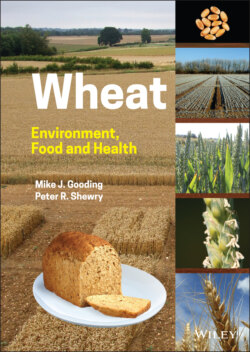Читать книгу Wheat - Peter R. Shewry - Страница 17
1.2.1 Vegetative Phase 1.2.1.1 Germination
ОглавлениеStarting with the germination stages, the dried grain (DGS 00) is markedly asymmetric (Figure 1.8) with the ventral side divided by a crease parallel to the long axis. The embryo is present at the germ end but typically 80% of the grain weight is allocated to the nutrient store of the seed, i.e. the starchy endosperm. The outer parts of the grain consist of compressed cell layers, notably the true seed coat (the testa) and the fruit coat (the pericarp), which, together with the outermost layer of endosperm cells (the aleurone), collectively form the bran on milling (Evers et al. 2006). Germination (DGS = 0n) starts in conditions that break or circumvent dormancy, and with adequate moisture, temperature, and aeration (Chapters 3 and 4). Water is imbibed and the aleurone cells are stimulated to produce hydrolytic enzymes that break down the endosperm to release simple sugars and amino acids for the growth of the seedling. Externally, the radicle (root) and coleoptile emerge (Figure 1.8). The coleoptile is a pale tube‐like structure that protects and facilitates the emergence of the first true leaf. The coleoptile elongates to the soil surface. At least three seedling (seminal) roots will usually have been produced before the plants emerge above the soil surface. The germination phase is complete when the first true leaf reaches the tip of the coleoptile which encases it. The apical meristem is raised towards the soil surface by expansion of an underground stem.
Figure 1.8 The germination phases of wheat. Boxed numerals are the decimal growth stage scores from Table 1.4.
